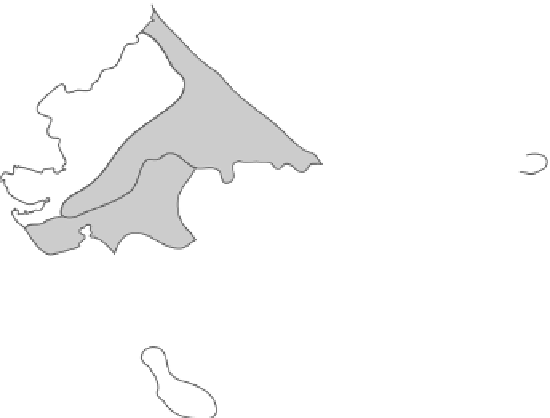Geography Reference
In-Depth Information
Figure 8-10
Patterns of agriculture. What is the relation-
ship between crop distribution and water
availability? Note that millet can be grown in
many different environments. Millet is a com-
mon food in many parts of Asia. In North
America, it is fed to livestock and sometimes
used as an ingredient in multigrain bread or
cereal.
M W
M W
R
M z
M R
W
R
S
M W P
C Mz S
M P
P
W R S
R
W R P Sg
R J
M W P
M R P
M R P
M P C
M R P
M R O
M C O
Arid
Humid
M R
Cn PC
Semi-arid
Coastal
M R P
S O
Subhumid
M
W
R
P
C
S
Mz
O
Sg
J
Cs
Cn
PC
Millet
Wheat
Rice
Pulses
Cotton
Sugar
Maize
Oilseed
Sorghum
Jute
Cassava
Coconuts
Plantation crops,
e.g., rubber,
pepper, cacao, tea
well owners have started water markets, selling their wa-
ter to others to open up even more farm land.
Timely application of water can increase yields
markedly , but supplies are overexploited in many areas.
Other areas have never had enough. Management agen-
cies lack coordination, and the entire issue of water, like
land, is very political. According to Robert Repetto, writ-
ing for the World Resources Institute (1994), “In India,
the rights to an immensely valuable resource [water]
were distributed gratis in a pattern even more unequal
than that of land distribution, reinforcing rural inequali-
ties in income and wealth.”
Thirty percent of India' is land is dry-cropped. With ir-
rigation, these lands could become relatively affluent. In
Maharashtra, experiments with water conservation, tree
planting, and grazing control have led to agricultural im-
provements and the creation of a viable market system.
Demise of the Jajmani System
In Punjab the custom was for Harijan laborers to
work for their Jat landlords in exchange for grain
and fodder. This was called the jajmani system.
Harijan laborers received one-twentieth of the
wheat harvest. This was much more than an








































Search WWH ::

Custom Search